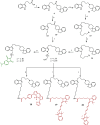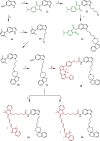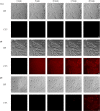Development of Fluorescent 4-[4-(3 H-Spiro[isobenzofuran-1,4'-piperidin]-1'-yl)butyl]indolyl Derivatives as High-Affinity Probes to Enable the Study of σ Receptors via Fluorescence-Based Techniques
- PMID: 36919956
- PMCID: PMC10041534
- DOI: 10.1021/acs.jmedchem.2c01227
Development of Fluorescent 4-[4-(3 H-Spiro[isobenzofuran-1,4'-piperidin]-1'-yl)butyl]indolyl Derivatives as High-Affinity Probes to Enable the Study of σ Receptors via Fluorescence-Based Techniques
Abstract
Sigma (σ) receptor subtypes, σ1 and σ2, are targets of wide pharmaceutical interest. The σ2 receptor holds promise for the development of diagnostics and therapeutics against cancer and Alzheimer's disease. Nevertheless, little is known about the mechanisms activated by the σ2 receptor. To contribute to the exploitation of its therapeutic potential, we developed novel specific fluorescent ligands. Indole derivatives bearing the N-butyl-3H-spiro[isobenzofuran-1,4'-piperidine] portion were functionalized with fluorescent tags. Nanomolar-affinity fluorescent σ ligands, spanning from green to red to near-infrared emission, were obtained. Compounds 19 (σ pan affinity) and 29 (σ2 selective), which displayed the best compromise between pharmacodynamic and photophysical properties, were investigated in flow cytometry, confocal, and live cell microscopy, demonstrating their specificity for the σ2 receptor. To the best of our knowledge, these are the first red-emitting fluorescent σ2 ligands, validated as powerful tools for the study of σ2 receptors via fluorescence-based techniques.
Conflict of interest statement
The authors declare no competing financial interest.
Figures










Similar articles
-
Sigma ligands with subnanomolar affinity and preference for the sigma 2 binding site. 2. Spiro-joined benzofuran, isobenzofuran, and benzopyran piperidines.J Med Chem. 1995 May 26;38(11):2009-17. doi: 10.1021/jm00011a020. J Med Chem. 1995. PMID: 7783132
-
Novel derivatives of 1-cyclohexyl-4-[3-(5-methoxy-1,2,3,4-tetrahydronaphthalen-1-yl)propyl]piperazine (PB28) with improved fluorescent and σ receptors binding properties.J Med Chem. 2014 Apr 24;57(8):3314-23. doi: 10.1021/jm401874n. Epub 2014 Apr 14. J Med Chem. 2014. PMID: 24697311
-
Novel and Selective Fluorescent σ2 -Receptor Ligand with a 3,4-Dihydroisoquinolin-1-one Scaffold: A Tool to Study σ2 Receptors in Living Cells.Chembiochem. 2015 May 4;16(7):1078-83. doi: 10.1002/cbic.201402712. Epub 2015 Mar 10. Chembiochem. 2015. PMID: 25757101
-
1-Cyclohexylpiperazine and 3,3-dimethylpiperidine derivatives as sigma-1 (sigma1) and sigma-2 (sigma2) receptor ligands: a review.Cent Nerv Syst Agents Med Chem. 2009 Sep;9(3):205-19. doi: 10.2174/1871524910909030205. Cent Nerv Syst Agents Med Chem. 2009. PMID: 20021355 Review.
-
The Sigma Receptors in Alzheimer's Disease: New Potential Targets for Diagnosis and Therapy.Int J Mol Sci. 2023 Jul 27;24(15):12025. doi: 10.3390/ijms241512025. Int J Mol Sci. 2023. PMID: 37569401 Free PMC article. Review.
Cited by
-
Recent Advances in the Development of Sigma Receptor (Radio)Ligands and Their Application in Tumors.ACS Pharmacol Transl Sci. 2025 Mar 7;8(4):951-977. doi: 10.1021/acsptsci.4c00711. eCollection 2025 Apr 11. ACS Pharmacol Transl Sci. 2025. PMID: 40242588 Review.
-
Sigma-2 Receptor Ligand Binding Modulates Association between TSPO and TMEM97.Int J Mol Sci. 2023 Mar 28;24(7):6381. doi: 10.3390/ijms24076381. Int J Mol Sci. 2023. PMID: 37047353 Free PMC article.
-
SIGMAP: an explainable artificial intelligence tool for SIGMA-1 receptor affinity prediction.RSC Med Chem. 2024 Nov 8;16(2):835-848. doi: 10.1039/d4md00722k. eCollection 2025 Feb 19. RSC Med Chem. 2024. PMID: 39618965 Free PMC article.
References
-
- Martin W. R.; Eades C. G.; Thompson J. A.; Huppler R. E.; Gilbert P. E. The effect of morphine- and nalorphine-like drugs in the nondependent and morphine-dependent chronic spinal dog. J. Pharmacol. Exp. Ther. 1976, 197, 517–532. - PubMed
Publication types
MeSH terms
Substances
LinkOut - more resources
Full Text Sources
Chemical Information

